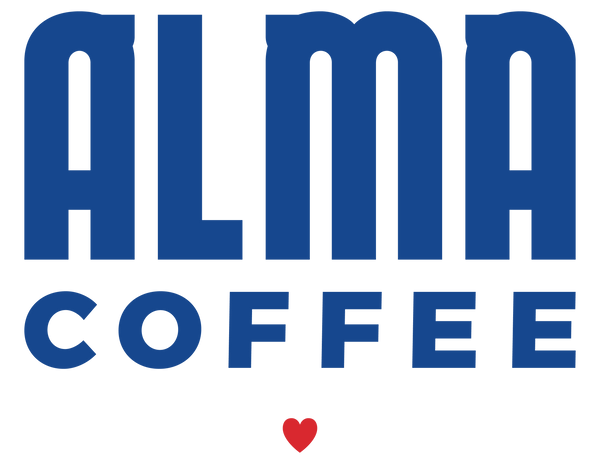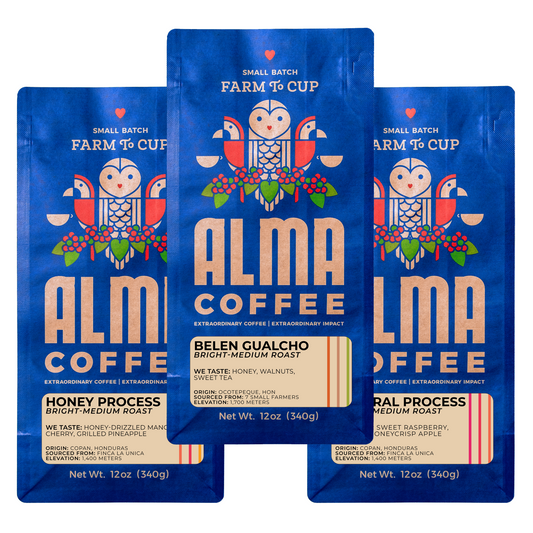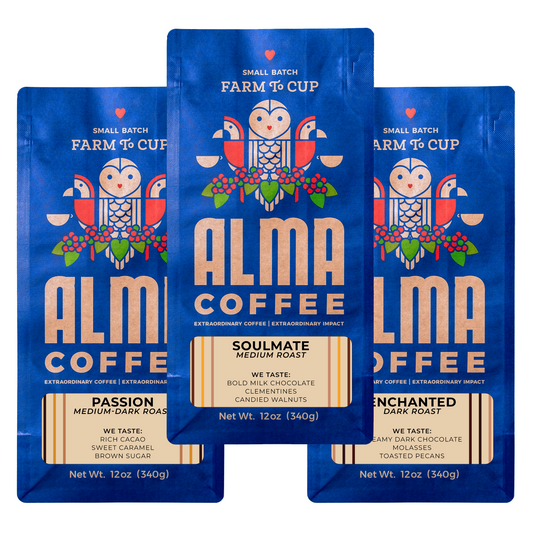
The Great Coffee Waves: What are the First, Second, and Third Coffee Waves? 🌊
Share
Coffee has seen an increase in consumer demand of epic proportion over the last 50 years.
If you remember when Nescafé was the hit new coffee trend, then you may already know what we’re talking about; but, those born and raised in the era of Starbucks might not be aware of just how sudden the shift to “coffee culture” has been, especially in recent decades.
This week’s blog post will give you a brief overview of the three major “waves” of coffee, what they represent in the evolution of coffee culture, and what we should expect in the “fourth wave” (if we haven’t already crossed that threshold).
So, grab a cup of coffee and sit back: we’re going to try our best to give you a crash course history lesson on the major moments of coffee history, or "waves," in 1200 words or less!
Blog Contents:
What are the "Waves" of COffee? 🌊☕️
Just like the “waves” of the industrial revolution or the “waves” of feminism, history buffs refer to major moments of transformation in the history of coffee culture as “waves.”
However, unlike feminism or industrial theory, the waves of coffee are focused specifically on how consumers interact with or relate to coffee as a consumable good, and that has changed significantly & swiftly with other historical and cultural trends around the world.
In a simple sense, the three waves of coffee represent how accessible or appreciated coffee was at certain points in time: the first wave represents the shift from novelty to commodity, the second wave represents a shift from commodity to culture, and the third wave represents a shift from culture to consumer awareness.
Of course, like anything in life, it is much more complicated than that. Keep reading to learn more about how the global consumer went from instant coffee to sustainably sourced, direct-trade coffee!
🌊1️⃣: From novelty to commodity
We’ve hinted in other blog posts about the origin of roasted coffee as a consumable good being in or around the 15th century, and this time stamp is universally accepted by coffee enthusiasts around the world.
But the leap from coffee's genesis to the ubiquity of Mr. Coffee drip machines is a steep one.
The first “wave” of coffee coincides with the first “wave” of the industrial revolution, which is defined by a global increase in mass-produced consumable goods—a few articles we’ve come across give a time range from the late 1800’s to 1920, but we won’t jump in on the debate this time around (See Oksnevad or Rothgeb).
We think that the best way to define the first wave of coffee is the shift from novelty to commodity. Before this moment, access to coffee in virtually any form was a privilege of the elite. The average person, aside from the coffee farmers who picked the beans, would have had almost no access to the benefits of our favorite bean prior to the manufacturing wonders of the industrial revolution.
That being said, this shift into widespread consumer affordability and accessibility didn’t happen overnight: companies like Folgers and Maxwell House made cheap, widely available coffee a grocery store staple by the mid 1950s. The idea of tasting notes, country of origin, washing process, or even understanding of the supply chain and how that influenced taste were wholly separated from the grocery shelves consumers were browsing.
Image courtesy of svipsx.com
This first “wave” was probably the longest of the four we’ll discuss today, mainly because the boundaries of where it begins and ends are still debated by coffee historians. But, we would mark the end of this wave by widespread accessibility to affordable coffee, likely between the 1950s and 1970s.
That being said, the rise of coffee as a commodity gradually sets us up for the second splash of coffee history...
🌊2️⃣: From COMMOdity to culture
Eventually, and for good reasons, coffee consumers started asking questions about what exactly was in their cup.
Sure, mass-produced coffee made it easy and affordable for the average person to stay caffeinated, but it also prioritized quantity over quality. The second wave of coffee signifies a shift in the expectations of consumers: although coffee had secured itself as a staple of consumer culture, a demand for higher quality & better tasting beans spiked by the 1990s.
TV shows like “Friends” and “Seinfeld” perfectly capture this transitionary period in coffee history: As cafés started popping up and becoming popular in metropolitan areas, new coffee companies like Starbucks saw an opportunity to capitalize on an emerging demand for a larger "speciality" market.
This was also a time where coffee shop popularity coincided with what some academics call the theoretical “third place,” or, in other words, a physical space that invited casual socialization with others in an escape from the office/home environment. Coffee shops seemed to open a new door for casual socialization that bars had been filling for centuries (See Parker).
If you watch(ed) sitcoms like Friends of Seinfeld, or if you plan to watch an episode or two after reading this, then you can clearly see how this theoretical “third place” became a popular cultural phenomenon amongst coffee consumers.
This wave also expanded the palate and expectations of consumers, too.
Rather than dousing black coffee in cream and sugar, the second wave of coffee introduced the larger market to steamed milk and espresso—cappuccinos, lattes, café au laits, and other staple café drinks were made more widely available by companies like Starbucks and perfected, specialized, or refined by local cafés and the talented baristas that staffed them.
🌊3️⃣: From CULTURE TO CONSUMER AWARENESS
This rift in coffee’s second wave between large companies and local artisans continued to widen as consumers switched their store-bought coffee for to-go lattes.
It wasn’t until the early-to-late 2000s that the “big guy” vs. “little guy” split in the coffee culture started forcing consumers to reflect on where, and not exactly how, their coffee was made.
Consumers in the third wave began to value the intricacies of coffee’s many origins and flavors, similar to how a wine connoisseur values their favorite fermented grapes. Even at the normal consumer level coffee brewing instruments for at-home use (like home grinders or espresso machines) started becoming affordable options for staying caffeinated.
This transition to at-home specialty coffee is a clear marker for the beginning of the third coffee wave, as consumer trends boosted the supply and demand of a specialty coffee market.
Coffee roasters and professional baristas also began seeing increased appreciation (and consumer funding) for their hard work.
Although huge coffee companies like Starbucks popularized the cozy and casual aspect of coffee cafes, the variability of brew time, roast profile, and grind setting started becoming common reference points for a new and growing segment of the coffee market—the "speciality" coffee consumer.
Additionally, The actual sourcing of “green bean,” the pre-roasted form of coffee, also saw wider recognition and appreciation amongst consumers at large. Unlike consumers within the first or maybe even the second wave, the actual supply chain (and the mistreatment of farm workers by large coffee producers) became top-of-mind for those interested in higher quality, more sustainably sourced coffee.
Organizations like the Specialty Coffee Association (SCA) have been a huge boost behind-the-scenes for increasing awareness and demand for specialty coffee at the consumer and industry levels, introducing the public to concepts such as "Direct-Trade."
However, we really need to thank the coffee shops, baristas, and local roasters who brought direct-trade, sustainably sourced coffee to the forefront of the industry. Without them, direct-trade roasters like us wouldn't be able to further the farm-to-cup mission!
4️⃣ The FOURTH wave: THE FINAL COFFEE FRONTIER?
And so, this brings us to the newest buzzword of the coffee industry: the “fourth wave.”
Although the transitions between each of the first three waves of coffee is clear in retrospect, they may not have been in the moment, especially if you consider all of the combined factors we've discussed in this blog that mark a coffee "wave." However, even if it takes decades, we expect the trend towards higher quality & more ethically sourced coffee to continue far into the future and, eventually, become a majority of the coffee consumer market (if it hasn’t already)
Does that mean we are in the fourth wave now?
We’ll leave that decision for the coffee historians to decide (like Trish Rothgeb, for instance). For now, we hope that this blog illuminated the history, definition, and impact of each of the first three waves of coffee, including the huge transformation coffee has undertaken in consumer culture in such a short amount of time.
As lovers of coffee in all forms here at Alma, we geek out anytime we get to take a deep dive into the history of our favorite caffeinated beverage. Until our next blog, be sure to leave a comment below and let us know what you remember from the three waves, or what you look forward to in the fourth wave.
Sources:
- Oksnevad, Dan. “The Differences Between 1st, 2nd, and 3rd Wave Coffee.” Driven Coffee, 24 Apr. 2020, www.drivencoffee.com/blog/coffee-waves-explained/.
- Ott, Brian. "Minimum-wage Connoisseurship and Everyday Boundary Maintenance: Brewing Inequality in Third Wave Coffee." Humanity & Society 44.4 (2020): 469-491.
- Packer, Randall. "Third space network: Theatrical roots." Lumina 11.2 (2017): 82-109.
- Rothgeb, Trish. “Norway and Coffee.” The Roaster's Guild, web.archive.org/web/20031011091223/roastersguild.org/052003_norway.shtml.
Written by: Kelley Bostian






39 comments
I fell victim to a scam online a few days back and lost about $20,000 usd to a fake trading platform online. I was heartbroken and I really needed help so I contacted a friend who linked me with a group of experts. I really did not believe I could recover my lost funds but thanks to JETWEBHACKERS They helped me within a space of 5 working days recover all my scammed funds including all my profits from the scam company. I am forever grateful and I hope people in my shoes get the help they need as well. Contact JETWEBHACKERS for more information.
Quickly reach out to JETWEBHACKERS, on their
EMAIL:jetwebhackers@gmail.com
TELEGRAM: @jetwebhackers
WHATSAPP: +1 (704) 252-2290
CONTACT SUPERIOR . HACK @ GMAIL . COM OR WHATSAPP +14106350697 for all your hacking jobs and pi jobs they are very competent and very god at what they do they helped me hack into my spouse phone and helped retrieve my stolen cryptocurrency they also helped my friend catch his cheating spouse you can contact them and be assured of a very good job you would come back on this platform testifying
REACH OUT TO BLOCKCHAIN CYBER RETRIEVE FOR LOST OR STOLEN CRYPT0CURRECY.
Have you ever felt a gut feeling that something just wasn’t right? My name is Elizabeth, and that’s exactly how I felt one evening while I was scrolling through my emails. I’m a recent graduate from Howard University, where I had discovered my passion for cryptocurrency trading. It started with a modest investment that grew significantly, and I was excited to watch my assets balloon to over $700,000. I had been doing everything right—researching trends, following the market, and sharing tips with my friends. But that evening, my instincts kicked in when I received an email that seemed suspicious, claiming it was from my cryptocurrency wallet provider. Despite my initial hesitation, curiosity got the better of me, and I clicked the link. Before I knew it, I had unwittingly entered my login details on a phishing site. Panic set in as I quickly realized I had fallen into a trap. My account was drained within minutes, and I felt a mix of fear and disbelief wash over me. I had worked so hard to build my investment, and now it was all slipping away. In my desperation, I reached out to my roommate, who had faced similar issues in the past. He recommended Blockchain cyber retrieve, a service I had never heard of before but was willing to try in hopes of salvaging my situation. From the moment I contacted them, I felt reassured. Their team was not only professional but genuinely empathetic, understanding the emotional turmoil I was experiencing. Blockchain cyber retrieve quickly got to work, securing my remaining accounts and meticulously tracing the fraudulent transactions. They collaborated with cybersecurity experts to track down the hackers and prevent further loss. Throughout the process, they kept me informed and educated me on how to recognize potential scams, emphasizing the importance of using strong, unique passwords and enabling two-factor authentication. The recovery took time and patience, but thanks to Blockchain cyber retrieve, I managed to recover a significant portion of my assets. More importantly, I learned invaluable lessons about online security and the necessity of staying vigilant in the digital world. If you ever find yourself in a similar predicament, I can’t recommend Blockchain cyber retrieve. Their dedication, expertise, and compassionate approach turned what felt like a hopeless situation into a manageable recovery. I am forever grateful for their help and can now move forward with renewed confidence, knowing how to better protect my investments. Trust your gut instincts; they can save you from. potential disaster.
WhatsApp:+1 520 564 8300
Website:https://blockchaincyberretrieve.com
Email:info@blockchaincyberretrieve.com
How To Get Back Lost Money From Amazon
Hello everyone I want to use this Medium to say big thank you to Lost Recovery Masters, for helping me to recover my stolen funds worth $80,000 through their hacking skills. I tried it, though I was skeptical but it worked and I got my money back. I’m so glad I came across them early because I thought I was never going to get my money back from Amazon after paying off platform payments from fraudulent Sellers. You can also contact them if you have lost your funds through Amazon. Their services are well recommended and they ensure maximum satisfaction to their clients. You can contact them via
Website: (https://lostrecoverymasters.com/)
Whatsapp (+44(7537-105921)
Support Email (Support@lostrecoverymasters.com)
ARE YOU A VICTIM OF INVESTMENT OR NFT SCAM? DO YOU WANT TO INVESTIGATE A CHEATING SPOUSE? DO YOU DESIRE CREDIT REPAIR (ALL BUREAUS)? SCHEDULE A MEETING WITH AN ETHICAL HACKER ASAP TO GET STARTED.
Let us show you the art of Ethical Hacking….!
EMERALD HACKS is a financial regulator, PRIVATE investigation and funds recovery body. We specialize in cases as regards ETHICAL HACKING, CRYPTOCURRENCY, FAKE INVESTMENT SCHEMES and RECOVERY SCAM. We are also experts in CREDIT REPAIR, we analyze what’s impacting your score.
All software tools needed to execute RECOVERIES from start to finish are available in stock.
Kindly NOTE that the available tools does NOT apply to CREDIT FIX.
Be ALERT to FALSE reviews and testimonies on the internet, the authors and perpetrators unite to form a syndicate.
Contact our team as soon as you can via the email address below to book a mail meeting with an ethical hacker.
emeraldhacks (.) org (@) gmail (.) com
Stay Safe out there !ii